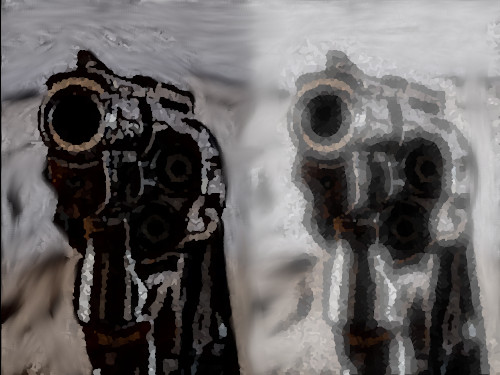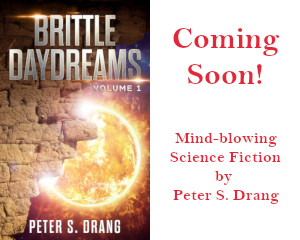“Zeroing Out His Wavefunction” (Science Fiction, 950 words), one of my stories, dropped today on Nature: Futures. This article contains notes on this tale of quantum entanglement and human entanglements.
Nature is a scientific journal, and one of the most prestigious at that. They have a section called Nature: Futures that posts one “hard” science fiction story each week. I’m very proud to have made it into this esteemed publication.
WARNING: There are spoilers in this article, so before continuing past this point please take the five or so minutes required to read this short story: Click Here to read “Zeroing Out His Wavefunction” on the Nature website.
Story Origins
My adult son is a writer and editor in Hollywood, and he always has great suggestions for Indy movies to watch. One night he was visiting and suggested a movie called Coherence. This was a low budget Indy movie that got many great reviews. It involved a group of friends having a party, and quantum weirdness started occurring at a human scale.
I loved the movie, but I noticed that they sidestepped the most highly weird quantum effects like nonlocality and entanglement. I thought to myself, what would those effects look like at a macro level?
That night I had a dream that answered that question, and even provided several of the sequences in the story. The vision of a woman looking into a mirror and having her face split into two realities was directly from the dream, as was the gun being both fired and not-fired.
“Nature” and Nature
The story refers to “Nature” several times, meaning the set of natural laws the universe is bound by–and not the Journal Nature. When I wrote this story, I actually wasn’t contemplating submitting it exclusively to Nature magazine, so that was just a coincidence. The first market I submitted this story to was Flash Fiction Online, but I think it turned out to be a little too much of a hard science fiction story for them, they tend to be more literary.
Theme
The theme of this story is “entanglement.” The main character is a woman who has personal entanglements with her abusive partner. She ultimately solves her problem by becoming entangled with him at the quantum level.
The Science
Nature: Futures wants “hard” science fiction stories. That means speculative science is front-and-center in the piece. It often also means the speculative nature of the science has to be at least plausible. The audience is composed of professional scientists, after all.
I will be the first to admit that I only have a layman’s understanding of quantum mechanics, based largely on popular press articles from places like Scientific American. I know for a fact that the “supersized” version of quantum mechanics presented in the story isn’t entirely self-consistent with actual quantum mechanics. It would be impossible to pull that off (I think) because quantum phenomena are indeed not directly observable at a human sized scale. It requires careful experiments under tightly controlled conditions to keep particles entangled for only a short time.
But, in my attempt to get as close as possible, the opening paragraph is key. Here, the main character momentarily splits into two versions of herself: one that lives in the world where Jimbo died, and the other in the world where he lived. She wills herself to “merge” those two selves back together. (Give me a little leeway here!). Now, she exists as a merged “particle” that can observe both worlds. In her eyes, dead-Jimbo and live-Jimbo appear as ghostly images, partial probabilities, bits of the same wavefunction spread out over space.
The Russian roulette idea was my attempt to bring probability into the story. I do understand that spinning a gun chamber most likely is not a fully random quantum event. But again, give me a little slack. The story was hard to tell without referencing things familiar to most readers.
The part about Jimbo entangling with anything he manipulates is, I think, a pretty fair representation of what happens at a quantum level to tiny particles. Whatever they affect also becomes entangled with them. Thus, when Jimbo starts eating cereal, the cereal box, milk carton, etc., all become entangled. There are now two ghostly versions of each of those objects: the one that exists in live-Jimbo’s world and the one in dead-Jimbo’s world. Live-Jimbo himself can only see the ones in his world. The main character can see both because she had the presence of mind to “merge” her two selves back together at the very start of the story.
The story concludes when Nature “decides” to collapse the wavefunction. The main character, at least the version of her that is narrating the story, ends up in the dead-Jimbo world that she desired. But there is still the possibility that Nature is actually not “collapsing” anything, but rather “splitting” all the logically consistent realities into their own separate reality. This is the Everett Many Worlds interpretation. The main character reasons that if that’s the case, then she’s dead in that other world, but takes heart that at least Jimbo will not likely escape the legal system since he’s literally standing over her holding a smoking gun as the police arrive.
Hey, What About Those Sirens?
One item that some readers point out is: In the world where the main character is killed, will the police really arrive to see the “smoking gun”? In that world the gun did not go off in the bedroom so the neighbors didn’t hear anything so didn’t call the police.
Good catch if you noticed that! However, I have an answer. The story establishes in the first paragraph that it’s possible for people to concentrate and will their branching selves back together shortly after a randomizing event, as long as their bodies have not changed so much that such a “merging” is impossible (Jimbo is out of luck, “even Nature” can’t merge a dead and living person back together). The police, being highly trained, have at least a few officers who will themselves back together after the neighbor’s calls in dead-Jimbo-world split them apart. Thus these “merged” police are indeed arriving in both worlds.
True, none of this is explained in the story. But explaining everything would just bog down the prose, and hey, I only had 950 words to work with, so I beg your indulgence!
Real Time and Minimalism
This story takes place in “real time.” The reading time of the story is just about exactly as long as the story lasts in the world of the characters. This is an extreme version of the “short timeframe” principle of writing flash. With exactly two characters and exactly one scene (the “camera” follows the main character in an unbroken sequence of events), this story uses the minimum possible story structure–assuming you’re going to have at least one protagonist and one antagonist.
Timeline
Here’s the full publication timeline for this story.
- Draft started July 2020
- Workshop comments integrated by end of July
- Submitted to Flash Fiction Online August 4, 2020. Declined with a personal note on August 22, 2020
- I held the story in limbo for a couple of months waiting for a prior sub to Nature to be declined, since I thought Nature was the next logical market for a hard SF story.
- Submitted to Nature on November 10, 2020
- Accepted on August 3, 2021. Contract signed the next day.
- Published on August 27, 2021
Total calendar time: 13 months from draft to publication. As you can see, Nature had a very long slushpile wait of about nine months. This is because Nature was so busy publishing articles about Covid that they had to put their fiction section on the back burner. Understandable!
Total actual writing time was around 2 to 3 hours including all edits and revisions.
Conclusion
This story came from watching a great Indy movie, then wondering how it could have better represented quantum phenomena, and finally dreaming up a plot. Although inspired by the movie Coherence this story is unique and focuses on additional aspects of quantum mechanics and a different set of interpersonal dynamics. You could say that this story is “in conversation” with Coherence.
See also: “Gator and the Big Buzz” Accepted by FFO
See also: Turning Everyday Life into Science Fiction Story Ideas



